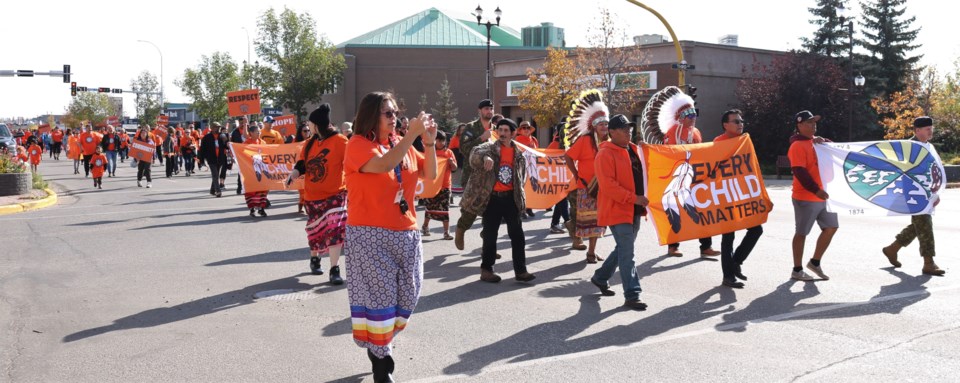YORKTON - National Day of Truth and Reconciliation was marked in Yorkton by an Orange Shirt Walk down Broadway Street followed by an afternoon presentation at City Centre Park.
Ivan Cote with event organizing Yorkton Tribal Council, and MC throughout the day said it was good to see the day being “more promoted in Saskatchewan,” adding it was supportive to see some businesses close to mark the day, something he hoped would grow with more closing in the years ahead.
Cote said it was important to see so many people out for the walk wearing orange given the story behind the coloured garment – the story of Phyllis (Jack) Webstad.
“I went to the Mission for one school year in 1973/1974. I had just turned 6 years old. I lived with my grandmother on the Dog Creek reserve,” read Cote of Webstad’s story. “We never had very much money, but somehow my granny managed to buy me a new outfit to go to the Mission school. I remember going to Robinson’s store and picking out a shiny orange shirt. It had string laced up in front, and was so bright and exciting – just like I felt to be going to school!
“When I got to the Mission, they stripped me, and took away my clothes, including the orange shirt! I never wore it again. I didn’t understand why they wouldn’t give it back to me, it was mine! The color orange has always reminded me of that and how my feelings didn’t matter, how no one cared and how I felt like I was worth nothing. All of us little children were crying and no one cared.”
Webstad’s story inspired the shirt to become a symbol for the walk in memory of children who died in residential schools, survivors of the schools, and their families.
Yorkton Mayor Mitch Hippsley said he saw the walk as an opportunity to learn.
“I am proud to walk, listen and learn with you today,” he said, adding in learning it must be truth.
“Truth comes first before reconciliation can begin.”
Hippsley added he feels that reconciliation “is all about healing,” so that we can all build a more vibrant community by “walking together in a good way.”
Vice Chief Heather Bear of the Federation of Sovereign Indian Nations said being in the park in the shadow of a new teepee sculpture was moving, suggesting she was “getting goose bumps on my goose bumps.”
And, also because the walk “recognizes an important day that all our children matter.”
Bear said it all started to become public with finding in B.C. where children, “loved ones that went missing,” were discovered in a “mass grave.”
From there other discoveries were made and a movement was born.
Through it all though First Nation people have persevered, said Bear.
“We are strong. We are resilient,” she said.
And now the young people of today are tasked with moving forward to a better future, a future that includes reclaiming their language and ceremonies.
It’s a path to reconciliation which is “about justice . . . forgiveness . . . about getting things right. It’s about treaty,” said Bear.
Bear said treaties cannot be forgotten or ignored, adding when the signatories “touched the pipe” it was a sign of commitment to those treaties and with the Creator and that included “to get along” with white settlers.
Chief Clinton Key of the Key First Nation took things back to the children who died in residential schools.
“I believe all our lost children are true warriors of our time,” he said.
Key questioned whether people would be gathered together on a day like Orange Shirt Day, coming together without the lost children as an impetus?
“I believe our children didn’t die in vain. We are here today because of them,” he said.
The event in Yorkton followed the official dedication of a large teepee sculpture in the downtown park Thursday, an installation funded by the YTC. Cote said it was only the second teepee installation on municipal land, calling its installation “a step in the right direction.”
Cote said there are those who have not been supportive of the teepee, but said they need to be ignored and the symbol accepted as a positive in the city.
Yorkton Tribal Council Tribal Chief Isabel O’Soup picked up on the story of the teepee.
“It is a great day, and an even greater day because we can see our teepee. I’m so pleased to see it every time I drive by,” she said.
O’Soup said the teepee should be a symbol to bring people together, but there are people on social media who have the installation story wrong, and on a day based on learning truth, she said she had to address that.
For example, the City of Yorkton did not pay for the sculpture. It was funded by the Yorkton Tribal Council, said O’Soup.
It’s important to learn truths, she continued.
For example, the land was not taken from First Nations. First Nations signed treaties that signified “we would share the land (in exchange) for certain benefits, said O’Soup, adding First Nations leaders at the time “believed the treaties they signed were a benefit for their people for the future.”
And, because both peoples signed the treaties O’Soup remind “we are all treaty people.”
Similarly, First Nations people pay taxes, even if some believe that is not the case, continued O’Soup. Those living off reserve pay property tax on homes, income tax on earnings, and sales tax on goods bought in off reserve stores.
“I say to people learn the truth,” she implored.






